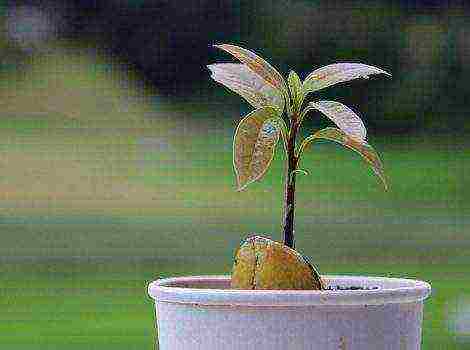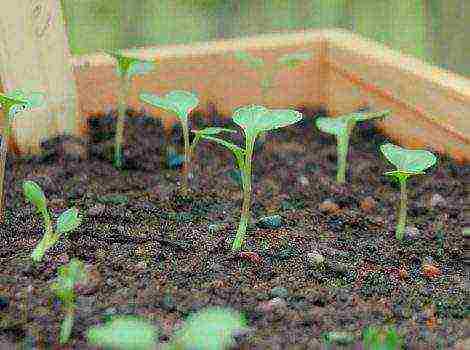Content [show]
Oyster mushrooms contain vitamin D2, which is considered quite rare. It is responsible for the normal absorption of phosphorus and calcium, therefore the product is recommended for people with weak bones, as well as for children with retarded physical development. One of the most important positive properties of oyster mushrooms is the ability of the vitamin to dissolve plaques from cholesterol. In addition, these mushrooms contain a lot of iodine.
Oyster mushrooms can be classified as dietary products, because 100 grams of the product contains no more than 40 calories. It can also be noted that they taste like meat, so they can be used as a substitute in many vegetarian dishes.

Stages
Mushrooms are grown according to a certain technology, the knowledge of which will help to get a good harvest at home. The two main products that will be required to grow oyster mushrooms are mycelium and substrate.

Stage 1
At this stage, you need to purchase the actual planting material, or mycelium. Currently, it can be ordered online or purchased from mushroom growing companies. When you first try to grow oyster mushrooms, you should not acquire a lot of mycelium. Indeed, even from a kilogram of planting material, you can get about four kilograms of mushrooms.
Storage of mycelium should be carried out in cold conditions at a temperature of only +3 degrees.
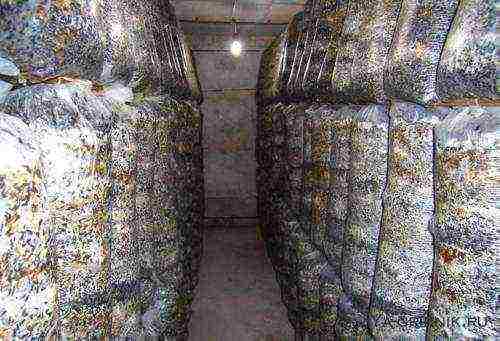
Stage 2
The second stage of growing oyster mushrooms is the preparation of the substrate. It is best to make the substrate from barley straw, corn cobs or buckwheat hulls. Sawdust is sometimes used, however, such a substrate is not the best medium for the development of oyster mushrooms at home.
When you have selected the raw material, it should be crushed and heat treated for decontamination. Next, the raw materials are boiled in water for two hours. If the substrate is soft, then one hour is sufficient. After that, the liquid is drained, and the substrate is cooled. It is important to note that the substrate for growing oyster mushrooms must be moist.

Stage 3
When the substrate is ready, and the mycelium is waiting in the fridge, it is necessary to create mushroom blocks. For this, polyethylene bags are suitable, the volume of which should be five kilograms. In this case, you need two bags per kilogram of mycelium.
Polyethylene containers must also be disinfected. They are washed with warm water and placed in a solution of bleach for two hours.
When the bags are disinfected, blocks are formed. The mycelium and substrate are stacked in layers, alternating one after another. Each layer should be about six centimeters thick. In this case, the top layer is always the mycelium. When the mycelium and substrate are in the bag, it is closed and perforated with 2 cm incisions. Such cuts should be staggered 15 cm apart from each other.
Further, the mushroom blocks are installed in a prepared place, where in the future the main development of oyster mushrooms will take place. For 14 days, the mushrooms will be in incubation, for which it is important to observe a special temperature regime: not less than +19, but not more than +23 degrees.
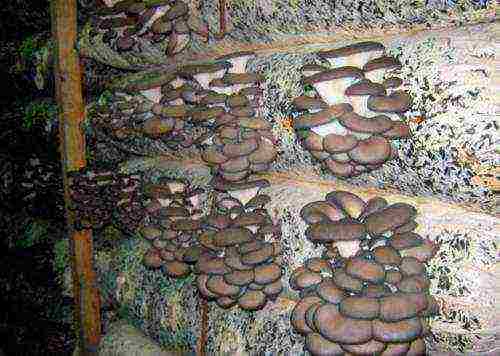
Stage 4
Growing mushrooms consists not only in preparing the mycelium and substrate, but also in proper care during the development of oyster mushrooms at home.For example, as soon as you put mushroom blocks to ripen, the temperature of the mycelium will rise, and it is very important here to prevent it from overheating.
To cool the mycelium, a fan is usually placed in front of the blocks. If the temperature is allowed to rise, the myceliums will simply die.
Oyster mushroom develops at home rather quickly. Already after ten days, you can observe how the mycelium penetrates the substrate and fills the entire mushroom block. At the same time, a characteristic mushroom smell appears in the room in which the mushrooms are grown. 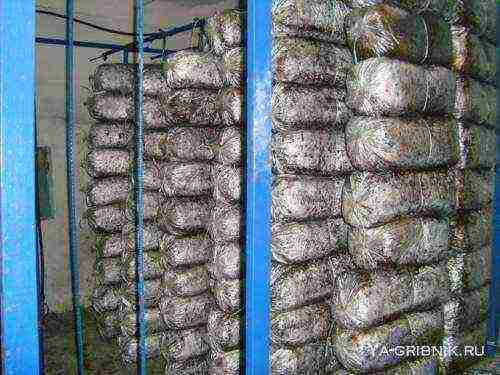
Stage 5
At this stage, the oyster mushroom begins to bear fruit, however, caring for the mushrooms does not end there at all.
After the incubation period, the room temperature should be +12 degrees.
Also at this stage of development, oyster mushrooms at home require additional lighting. It is created using fluorescent lamps that replace daylight for eight hours. In the room where the mushrooms are grown, it is important to increase the humidity. It should be 90%. But even in this case, it is important to ventilate the room, moreover, to do this at least four times a day.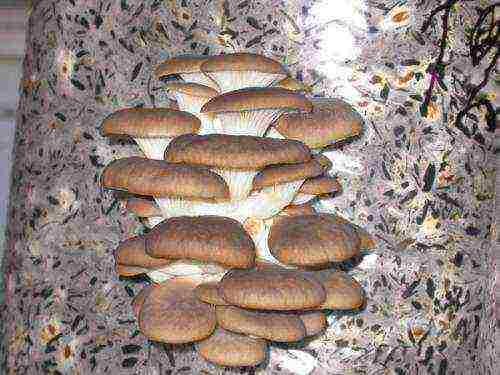
Sometimes beginners in the process of growing these mushrooms ask themselves: how to increase the humidity to such a high percentage? The room must be chosen appropriately so that the necessary conditions can be created by a variety of methods. An increase in humidity can be achieved by spraying the walls with water. However, it should be borne in mind that the liquid should not get on the oyster mushroom mycelium.
Oyster mushrooms appear in the previously made cuts in the bags. Mushrooms bear fruit for only two weeks. When the caps of the oyster mushroom grow many times over, the mushroom harvest can be harvested. In this case, the oyster mushrooms need to be twisted, and not cut off with a knife.
Stage 6
When you've harvested your first crop, it's important to get ready for the second, which will show up in two weeks.
It is worth knowing that at least four crops are harvested from one planting of mycelium at home.
However, not all of them will bring a lot of oyster mushrooms. Most of the mushrooms you can get from the first and second fruiting. After the last collection, the myceliums are changed to new ones, and the old ones can be used as fertilizer for the garden. 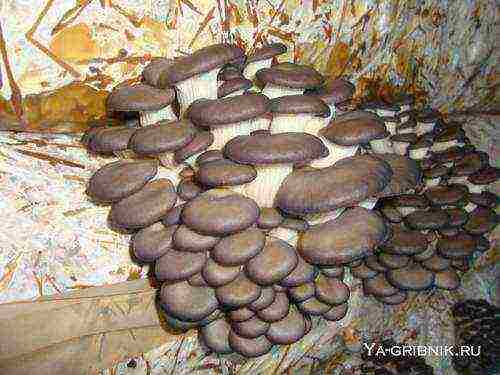
If you want to grow oyster mushrooms at home, but do not want to mess with mycelium and substrate, you can purchase ready-made blocks of mushrooms and simply put them into the room from maturity, having previously created the necessary conditions.
Growing on stumps
In addition to plastic bags, you can use hemp to grow oyster mushrooms. However, this method is considered to be longer, and the yield will depend on the weather.
Hemp is prepared in January. For this, a material with a healthy and even surface is selected. The stumps should be free of mold. Before growing oyster mushrooms at home, hemp is placed in water for three days in order to immediately increase their moisture content. Sow mycelium on this material in several ways.
- Make holes in the stumps that are six centimeters deep. And the diameter is 10 mm. Fill them with seed and cover the holes with tape. With this method of planting, it is best to use granular mycelium;
- Cut a disk on top of the stump, put the mycelium on the stump and cover it with the sawn part. The disc can be driven in with nails for better fixation and reliability;
- Some oyster mushroom lovers prefer to make something like a pyramid out of stumps. In this case, their ends are covered with mycelium two centimeters thick. The void between the stumps is filled with wet sawdust and wrapped in foil.
When the planting material is on the stumps, they should be taken to the basement at a temperature of +15 degrees. The mycelium will mature in this position for about three months. During this period, the basement must be ventilated, and the air in it must be humidified. When white bloom appears on the stumps, the wood material can be taken out to the site. But this should be done in May.It is at this time that the threat of frost is minimal. It is important to put the hemp in the shade, because the mushrooms will not bear fruit in the sun. It is important to choose a location where there are many trees with dense foliage.
The stumps should be installed in previously made 15 cm deep pits with damp foliage. The stumps themselves should be in a hole at a distance of 50 cm from each other. It is not difficult to take care of the mycelium. It is important to supply it with moisture on time, irrigating the land with water. Fruiting should be expected at the very end of summer. In warm weather, it can last until November.
What is oyster mushroom sick with?
If you notice that the fruiting period does not want to come, it is possible that the mushroom is sick with green mold. Cobweb mold can be caused by the dactylum fungus. As a result of the disease, the shape of the oyster mushroom changes. If the temperature is disturbed during the incubation period, hairy mold may develop. Orange or brown mold can interfere with mycelium development.
In addition to harmful fungi, poorly processed substrate can cause the appearance of woodlice, springtails, ticks, mushroom mosquitoes. As you can see, the oyster mushroom has quite a lot of enemies and competitors, therefore, in order to prevent it, special attention should be paid to the surrounding conditions and to carry out all the procedures for its cultivation according to technology.
To grow these mushrooms, it is important to know not only the technology, but also their varieties.
Oyster mushroom is one of the most popular varieties. According to its physical characteristics, it differs in a purple hat. She has excellent taste, and most importantly, she gives a good harvest at home.
Oyster mushroom is distinguished by a light brown cone-shaped cap. Hence its name. Usually it is grown at home on the stumps of an elm tree. Its aroma is quite specific, but the mushrooms themselves are elastic and tasty.
Pink oyster mushroom, otherwise Pink Flamingo, is distinguished by interesting external data in the form of a pink cap wavy at the edges. The variety is very fond of heat, so the temperature in the room for it can be increased up to +30 degrees. Differs in early fruiting - mushrooms can be harvested within 10 days after planting the mycelium.

Lemon oyster mushroom is distinguished by a bright cone-shaped hat with a diameter of up to 10 cm. This variety is good for its unpretentiousness to the surrounding conditions.
Steppe oyster mushroom, or yeringi, or Royal, is considered the most delicious of all varieties. These are mushrooms, soft in consistency, with a large funnel-shaped stem. Royal oyster mushrooms are grown in large cans.
Oyster mushroom is the most common and very productive variety.
Light beige Florida oyster mushroom has a wide cap, the diameter of which reaches 20 cm. It differs in that it requires higher temperatures as growing conditions than all other varieties.
The white elf is considered the most dietary variant of the mushroom. Has an unusual appearance in the form of a curly porcini mushroom with a scaly cap.
Pulmonary oyster mushrooms are eaten immediately after harvest, as stale mushrooms are hard.
Late oyster mushroom has the largest cap, the diameter of which often reaches 25 cm. When the mushrooms ripen, their color is dark, but by the time of harvest the oyster mushroom brightens. Feels great on oak or aspen stumps, as well as on a straw substrate.
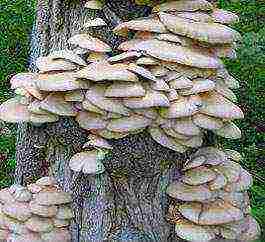 Hello dear readers! Today I will tell you a little about the benefits of oyster mushrooms, what types of these mushrooms are, as well as how to grow oyster mushrooms in the country or at home. The main advantage of this type of mushroom is its high yield, as well as ease of cultivation. And although the cultivation of oyster mushrooms is quite a feasible task, nevertheless there are specific requirements here. But, as they say, before we did not know how to walk, but we learned ...
Hello dear readers! Today I will tell you a little about the benefits of oyster mushrooms, what types of these mushrooms are, as well as how to grow oyster mushrooms in the country or at home. The main advantage of this type of mushroom is its high yield, as well as ease of cultivation. And although the cultivation of oyster mushrooms is quite a feasible task, nevertheless there are specific requirements here. But, as they say, before we did not know how to walk, but we learned ...
Growing oyster mushrooms at home is possible in several ways. I will tell you about the method of growing oyster mushrooms on stumps (more precisely, on logs).But for running a mushroom business, other methods are often used: growing on substrates, on sawdust, on straw blocks ...
Characteristics of the fungus
Unlike porcini mushrooms, aspen mushrooms, boletus mushrooms, which belong to mycorrhizal fungi growing in symbiosis with plants, oyster mushrooms are saprophytic mushrooms. They grow on predominantly deciduous trees (and stumps) and thus cause wood destruction. Oyster mushrooms are rarely found singly, mostly they form multi-tiered clusters consisting of 30 or more mushrooms.
Nutritional value and benefits of oyster mushrooms
Oyster mushrooms are a valuable dietary product. They are distinguished by their low calorie content (only 38-41 kcal) and a complex of useful substances, which includes:
- highly assimilable proteins and amino acids, including essential ones;
- fats, including polyunsaturated fatty acids;
- carbohydrates (glucose, fructose, polysaccharides, fiber);
- various minerals (potassium, selenium, iron, zinc, copper, etc.);
- vitamins (C, PP, E, D, group B).
The tender, fleshy pulp of young mushrooms has a pleasant smell and taste. But over time, it becomes tough and fibrous.
These mushrooms are used in processed form: they are boiled, fried, stewed, salted, dried and pickled.
Medicinal value
Interestingly, with regular consumption of these mushrooms, the level of cholesterol in the blood decreases. Oyster mushrooms not only prevent the development of atherosclerosis, but also have an antitumor and immunomodulatory effect on the human body.
Types of oyster mushrooms
Today on sale you can find the following types of oyster mushroom mycelium:
Oyster mushroom
It is a fairly large mushroom. The diameter of the cap varies from 3 to 15 cm, the height of the leg is 1-4 cm. The color of the cap is variable: gray, brown, as it matures - ash-gray or brown with a purple tint. The shape is round or shell-shaped.
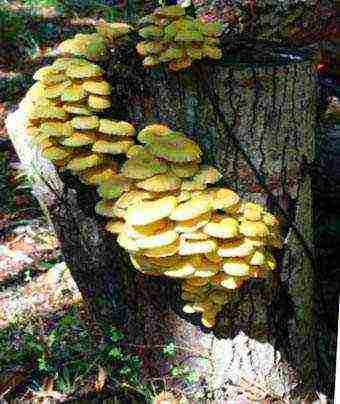 Oyster mushroom gold (or lemon)
Oyster mushroom gold (or lemon)
In the wild, this species grows only in the Far East. The hats have a bright, rich lemon-yellow color and reach a size of 3-10 cm.They are located on legs 1-4 cm high.
Indian oyster mushroom (or pulmanaris)
Pulmanaris is the most common type of oyster mushroom in nature. A grayish-white (or grayish-brown) mushroom head measuring 5-20 cm is located asymmetrically on a very short stem.
Colombian oyster mushroom
This species is one of the rarest. The only difference from oyster mushroom is the color of the cap, which varies from blue-pink to purple.
Royal oyster mushroom
It is not for nothing that it is called royal. This is the most delicious type of oyster mushroom and is especially popular in Europe. The fruiting body of the fungus consists of a brown cap measuring 3-12 cm and a thick stem 3-7 cm high.
Pink oyster mushroom
This species is probably the most exotic of all oyster mushrooms, and most importantly, fast-growing. Mushrooms have a delicate pink color, the size of an oyster mushroom.
Oyster mushroom growing technology
Oyster mushroom is successfully grown outdoors, in natural conditions. But the cultivation of oyster mushrooms indoors with an air temperature of + 10 ... + 27 ° C allows you to get a harvest of fresh mushrooms throughout the year, regardless of the season.
To grow mushrooms on stumps (logs), you will need:
- ready-made oyster mushroom mycelium (on wood sticks);
- wood base - a log of any hardwood (poplar, birch, maple, mountain ash, willow), which should be healthy, fresh, moist, with bark, but without branches;
- polyethylene film;
- sterile gloves.
Dates for planting mushrooms:
- outdoors - in spring (from April to June inclusive) and summer (from August to September);
- indoors - at any time of the year.
Recommendations for growing and caring for oyster mushrooms:
- Holes are prepared in the log using a drill (0.8-1 cm in diameter and 4 cm deep) at a distance of 10 cm, which are staggered.
- Using gloves, mushroom sticks are carefully taken out of the bag and inserted into the holes until they stop.
- The log is wrapped in polyethylene. After the log has been wrapped, several small holes should be made for air intake. Then, the logs prepared in this way are placed in a dark place with high humidity for mycelium overgrowth.
The rate of formation of white plaque (mycelium) on the surface of the log depends on the temperature regime. At a temperature of + 10 ° C this process will take 3-4 months, at a higher temperature of +20 ° C - 2-3 months. - After the mycelium has appeared on the surface of the logs, proceed to the next stage. In the garden, they choose an area protected from the sun and wind, where they prepare a hole. The depth of the hole should be about 10-15 cm. Its bottom should be watered and then we place a log overgrown with mycelium in it (vertically). The log is covered with earth for a third or half of its length.
- It is recommended to sprinkle the soil around the log with wood ash. This will help control pests such as snails.
- Watering is carried out once a week. The irrigation rate is 5 liters per 1 m2. In late autumn, before the onset of frost, the log is covered with plant residues (fallen leaves, straw).
- In the spring of next year, the bookmark is freed from the leaves and proceeds to regular watering. First, every week, at the onset of the ripening period of the fruit bodies - every day.
Fruiting of mushrooms occurs in waves and depends on the type of deciduous species and the type of oyster mushroom. So, when growing oyster mushroom on soft wood (birch, willow, poplar) fruiting occurs after 4-6 months and lasts up to 4 years, and on hard wood (maple, beech, mountain ash) fruiting occurs after 8-12 months and lasts 5- 7 years.
Temperature + 15 ... + 25 ° С is optimal for the formation of fruit bodies. Oyster mushroom yield is 20-50% of the total weight of the log.
Well, there is some information on how to grow oyster mushrooms and now all that remains is to try to apply it. Try it, perhaps your hobby will lead to a mushroom business and will bring you not only pleasure, but also profit.
Now there is little to do: choose mycelium (these mushrooms have quite a lot of species), prepare the necessary materials and start growing oyster mushrooms.
Good luck!
I advise, dear readers, not to miss the publication of new materials on this blog.
Best wishes, Gardensha
The genus of mushrooms "oyster mushroom" has many varieties, hybrids. Today, thanks to cultivation, it has become available to grow them at home. All types of oyster mushrooms are united by one feature - lush, hanging from the habitat of mycelium. The density of the fruiting bodies, as well as the size of the cap (from 10 to 30 cm), is influenced by the structure and degree of moisture of the substrate.
The color of the cap of the oyster mushroom can be yellow, grayish, lilac, white, even pink. This mushroom has predominantly white juicy flesh if it is young. Older specimens have a stiffer, fibrous consistency. At home, they can grow and bear fruit all year round. The main thing here is to competently maintain the required level of humidity, lighting, and air temperature.
Oyster mushroom varieties
Let's look at the most popular types of oyster mushrooms that are popular with home-based mushroom pickers:
1. Oyster oyster mushroom is one of the most popular and valuable types due to its excellent taste. The hat can be slightly lilac or brown. This variety feels comfortable when grown at home, and with the proper approach to business, it pleases with a harvest all year round.
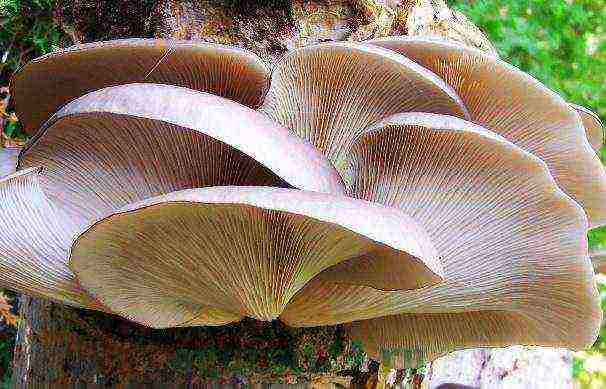 Oyster mushroom
Oyster mushroom
2. Oyster mushroom has a cone-shaped cap, therefore it bears this name. In artificial conditions, it is grown on stumps, mainly elm. The color of the cap ranges from light brown (sandy) to dark brown. Has firm pulp, pleasant, albeit slightly specific aroma.
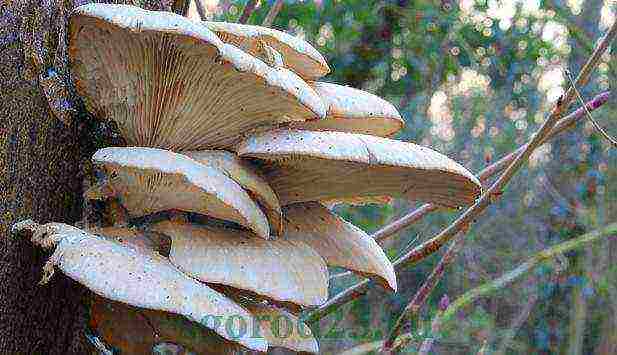 Oyster mushroom
Oyster mushroom
3. Pink oyster mushroom has another name - "Pink Flamingo". It is a beautiful, fast-growing mushroom with wavy edges of the cap, delicate pink color. This variety is thermophilic and requires an individual temperature approach (from + 16 ° C to + 30 ° C at different stages). Begins to bear fruit already 10 days after sowing the mycelium.
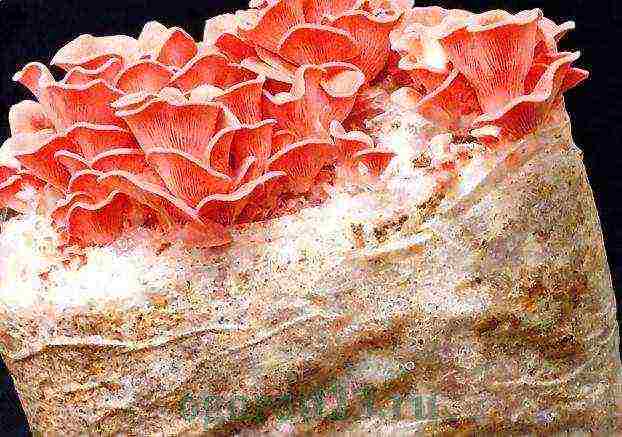 Pink oyster mushroom
Pink oyster mushroom
4. Lemon oyster mushroom (or ilmovik) has a bright conical cap. This variety is distinguished by its unpretentiousness to growing conditions, it is grown both on a substrate and on stumps. It is characterized by the closeness of fruiting bodies, graceful elongated legs. The diameter of the cap varies from 5 to 10 cm.
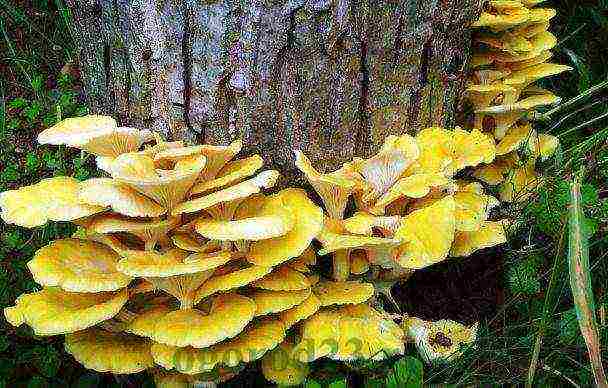 Lemon oyster mushroom
Lemon oyster mushroom
5. Steppe oyster mushroom (eringi) is also called Royal. This is the most delicious variety of oyster mushrooms, it has a fleshy dense pulp, a massive funnel-shaped leg. The mushroom cap (5-10 cm in diameter) changes as the mushroom grows: at first it is convex, then it becomes flat, and by the time of harvesting it is already concave. This species is grown in special large jars or cans (photo below).
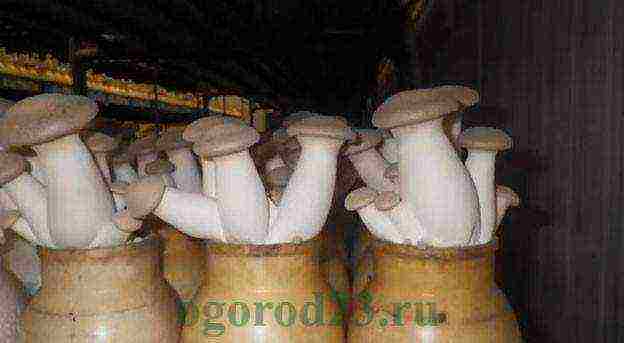 Royal oyster mushroom (steppe)
Royal oyster mushroom (steppe)
6. Oyster mushroom - the most popular variety, grown on stumps or on various substrates. Yields a harvest from summer to the very frost. Has a grayish yellow or brown cap.
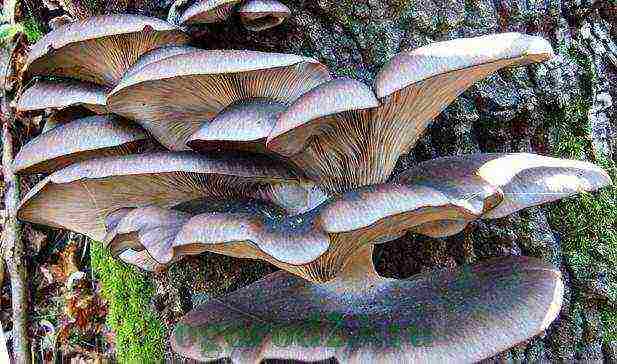 Oyster mushroom
Oyster mushroom
7. Florida oyster mushroom is a light beige or grayish-white mushroom with a semicircular, slightly funnel-shaped cap (10-20 cm in diameter). Requires higher temperatures during the growing and fruiting stages.
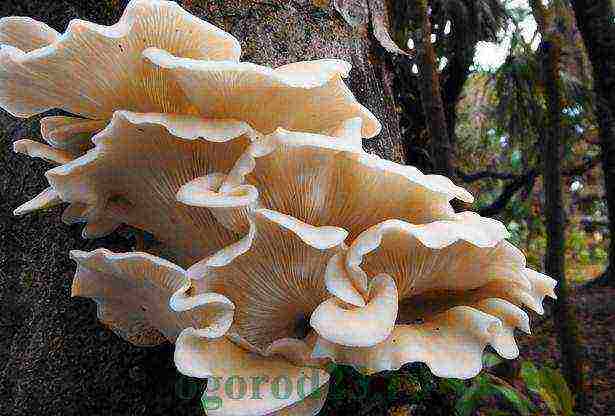 Florida oyster mushroom
Florida oyster mushroom
8. Oyster mushroom - is eaten or processed only by young mushrooms, as "old" mature mushrooms are characterized by increased rigidity. The cap of the mushroom has a tongue-like shape with slightly cracked edges, the color is white or brownish-cream. Pulmonary oyster mushroom bears fruit from spring to the first cold weather.
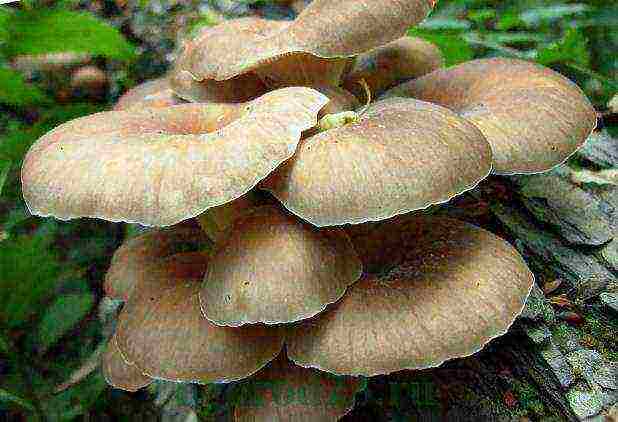 Oyster mushroom
Oyster mushroom
9. Late oyster mushroom is a mushroom with an exquisite, pronounced taste. It can be brown, gray or brown in color. It has an ear-shaped cap that can reach large sizes (up to 25 cm in diameter), young mushrooms are darker in color, mature ones are lighter in color. It is grown on stumps or chocks (oak, poplar, aspen), as well as on substrates (straw, sunflower).
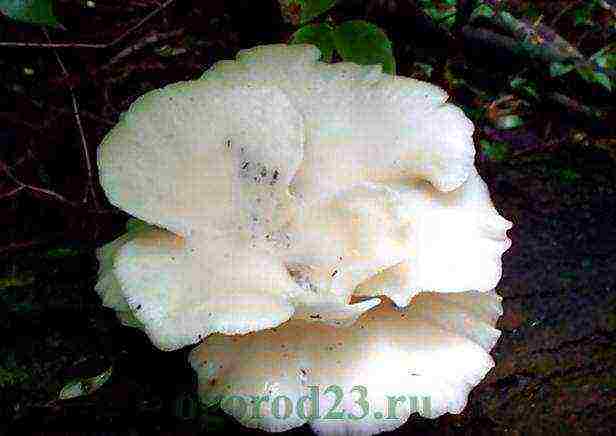 Oyster mushroom late
Oyster mushroom late
10. White Elf is a very tasty dietary variety. Has an elongated solid leg. The caps of this mushroom are white with slightly curly edges. The surface of the cap may be scaly. It is grown both on chocks or stumps, as well as on substrate blocks.
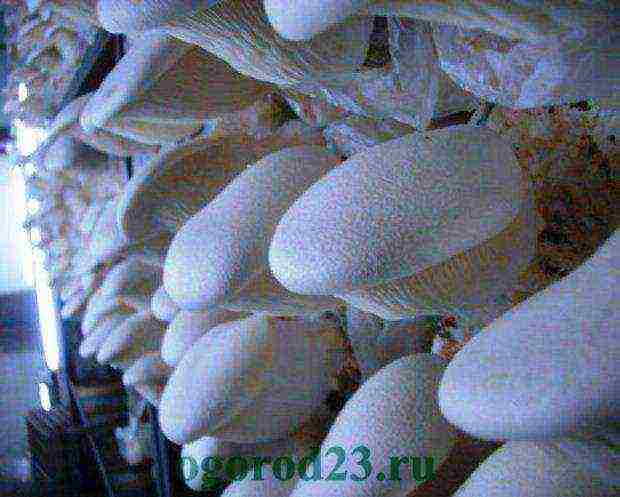 Oyster mushroom White Elf
Oyster mushroom White Elf
The above varieties of oyster mushrooms feel great when grown artificially. With proper care, they bear fruit abundantly. It is also worth mentioning hybrids, which are distinguished by high yields and unpretentiousness. The hybrids most preferred by mushroom pickers are: Dune NK-35, R-77, R-20, No. 420, No. 107.
Remember that you need to unpack the bags with mycelium only with gloves, the material should be purchased from trusted sellers, the mycelium itself should be without black or green spots.
All of the above types of oyster mushrooms are adapted for growing at home.
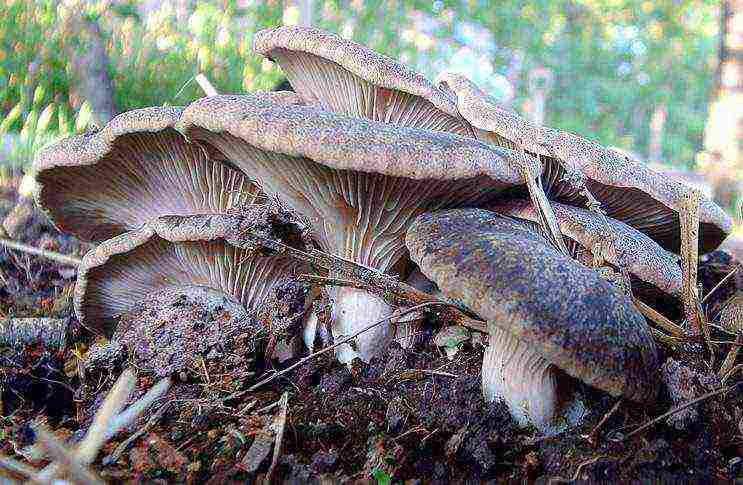
If you plant oyster mushrooms in your garden, you will be with mushrooms all summer and autumn. Caring for them is simple and does not require a lot of space. Like summer mushrooms, oyster mushrooms grow only on dead wood, giving preference to aspen, birch, poplar. In addition, it is very easy to grow oyster mushrooms at home.
Oyster mushrooms - common, or oyster, pulmonary, pink, or "flamingo", lemon-cap - rather large mushrooms. Their caps are from 5 to 20 cm in diameter, the color, according to the type, is gray or grayish-brown, cream, pink and lemon. The plates running down the lateral peduncle are white, or pinkish, or yellowish, and the spore powder is always white. The legs are very dense, tough, and are not eaten.
Usually oyster mushrooms appear on wood in the form of large groups, in which up to 30 individual mushrooms can be counted, and the weight of such intergrowths is 2-3 kg.
Oyster and pulmonary oyster mushrooms can often be found in the forests of central Russia, where they grow all summer and autumn. Especially a lot of fibo appears in August-October. Lemon-hat oyster mushroom comes from the Far East, and pink is a guest from the subtropics.
Growing oyster mushrooms is much easier than other edible mushrooms, most of which are not inferior in taste. They can be eaten fried, stewed, or in soups. These mushrooms do not lose their taste and are well preserved when dried and pickled (especially oyster mushroom).
And yet, how to grow oyster mushrooms at home? Let's take a closer look.
What and how to plant for growing oyster mushrooms?
Planting material - sterile grain mycelium. You need to buy it, but now this is not a problem, since many enterprises are engaged in oyster mushroom breeding. It is necessary to order mycelium in spring or early autumn, because it can be transported only at freezing temperatures. But it should be stored before planting in the refrigerator (0-2 ° C). At this temperature, the mycelium remains viable for 3-4 months, and at 18-20 ° C - only one week.
After the acquisition of mycelium in early spring, wood chocks of deciduous species (aspen, birch, poplar, etc.) are harvested with a length of no more than 30 cm and a diameter of at least 15 cm, since thinner ones give a smaller yield. They are soaked in water for one or two days. Then they are transferred to a cellar, basement or other closed room and the mycelium is applied to the upper ends with a layer of 1-2 cm.
The chocks are placed one on top of the other, forming a column up to 2 m high. The consumption of mycelium is 70-100 g per piece of wood. The column is covered with a layer of straw, matting, burlap, but not with plastic or other film: it does not allow air to pass through. The shelter helps to maintain moisture and better growth of mycelium, which will gradually penetrate the wood.
As a rule, at a temperature of 10-15 ° C, the mycelium penetrates into the tree in 2-2.5 months. During this period, the air in the room must be humidified, but so that water does not get onto the wood.
How to grow oyster mushrooms at home?
Oyster mushrooms need light for fruiting, so the next stage begins in May. The chocks overgrown with mycelium are transferred from a closed room and dug into the ground, deepening by 10-15 cm. At the same time, they are placed every 35-50 cm in rows. The place is chosen shaded, under the canopy of trees or under a light artificial canopy. Oyster mushroom care consists in carefully watering the soil in dry weather.
How to grow oyster mushrooms in a winter greenhouse?
Here you can grow oyster mushrooms in October-January, when it is usually empty. And the ability to regulate the microclimate (humidity and temperature of air, soil) creates more favorable conditions for the development of fungi.
Lumps are placed in the soil of the greenhouse in October - November, installing in rows, and not in a column. They deepen into the soil in the same way as when growing outdoors. At the same time, a layer of grain mycelium is applied to the upper end of the wood. It is covered with a wooden disk, equal in diameter to the surface of the tree and 2-3 cm thick.
At an air temperature of 13-15 ° C and a relative air humidity of 95-100%, the overgrowth of wood by mycelium occurs in 1-1.5 months. These are the conditions that need to be maintained during this period. When the mycelium grows, to stimulate fruiting, the air temperature is lowered to 2 ° C for two days, and then raised again to 14 ° C.
After 2-2.5 months after placing the chock with mycelium in the greenhouse, you can harvest. When planted in October, you will have fresh mushrooms by the New Year. If in the spring the greenhouse is needed for growing vegetables, then the round timber after overgrowing with mycelium can be transferred to open ground.
What is the yield when growing oyster mushrooms at home?
Usually mushrooms appear in August - September and grow throughout October (with the exception of the thermophilic pink oyster mushroom). When collecting, they are carefully cut off. On average, more than 600 g of excellent mushrooms can be obtained from one piece of wood during the first harvest. They are left to winter in the same place. Under favorable conditions, in the second year, each piece of wood can produce 2-2.5 kg of mushrooms. The largest harvest occurs in the second and third years.
Oyster mushroom mycelium preparation
I want to share with amateur mushroom growers my experience of harvesting oyster mushroom mycelium.
It is not the first year that I have been growing these mushrooms on stumps in the garden. There was a good harvest in 2014. But in 2015, due to the catastrophic heat, it was unsuccessful. It seems that all the mycelium sown on a dozen stumps has disappeared, and it will be necessary to "sow" them again. In general, I decided that it is necessary to harvest the mycelium in sufficient volume. And February-March is the most suitable time for this.
I buy mycelium. Fortunately, in our city there is a large selection - for every taste. But it is very expensive for an ordinary pensioner (I used to buy 2-3 kilogram packs of well-sprouted mycelium for the price for which they sell today only one pack of 100-250 g).
Based on some experience with oyster mushrooms, I have every reason not to trust the instructions according to which 100 g of mycelium is enough for 50 kg of wood (when sown on stumps) or for 2.5-3 buckets of dry plant residues (when grown in bags).
And also the fact that "... from the area sown with one packet of mycelium, they collect" 35 kg of mushrooms per season ... ".
It was necessary to look for a way out in order to obtain the required volume of mycelium at low cost. So I asked myself a question: why is it impossible to infect them (in accordance with the instructions) with the required volume of the substrate in the bag, germinate it and hide the sprouted mycelium in the refrigerator before its further use?
How to grow oyster mushrooms: preparing mycelium
At the end of January I bought a 100 gram bag of fresh mycelium (manufactured in 2013). For two weeks the package lay in the refrigerator, downstairs, in the section for vegetables. In early February, I prepared about 3 liters of substrate. As a basis, I used dead wood of tall flowers, a couple of handfuls of husks from seeds, crushed shells from two eggs. I steamed it all, cooled it down. Then he added 1 tbsp. presoaked wheat, mixed the substrate well with the infected grains from the bag and "charged" them with two plastic bags (more convenient for storage and use than one large one). I put them on the top shelf in the kitchen. It is already noticeable how the mycelium begins to assimilate the substrate. As a result, you should get about 1.5 kg of mycelium - this is 15 times more than originally in the purchased package.
Later, I will put the bags with the sprouted mycelium in the refrigerator until the beginning of May - when I start infecting the wood with it.
The idea is obvious. I am sure that this method is already used by many - and simply, and the savings are obvious. Therefore, if you like oyster mushrooms, it is not difficult to organize growing at home, and everyone can do this, because for this it is not necessary to have special rooms and to understand in detail the science of mushrooms.
